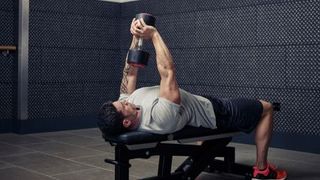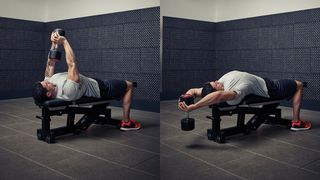How To Do The Dumbbell Pull-Over
Hit your your lower chest and lats with this single-joint move

We’d all love to be able to spend hours at the gym doing a series of laser-focused exercises that target each muscle in turn, but for most people that isn’t practical. Instead you have to be smart and pick exercises that provide the maximum return on time invested, and the dumbbell pull-over is most decidedly one of those exercises.
So the next time you’re in the gym worrying about whether you have the time to hit your pecs and lats during a workout, worry no more, because the dumbbell pull-over is a superb exercise for both.
Despite this, it’s an exercise that’s gone out of fashion since its heyday during the 1970s when it was popular with Arnold Schwarzenegger and his bodybuilding ilk. But all that means is that people will start copying you when you start doing dumbbell pull-overs in your local gym, especially when they see the barrel chest it helps you build. And rest assured that you don’t need a body like Arnold’s to do the dumbbell pull-over and enjoy its benefits. All you do need, in fact, is a dumbbell and a bench.
How To Do The Dumbbell Pull-Over

Lie down on a bench with your head and upper body supported, and your feet planted on the floor. Hold a dumbbell in both hands above your chest. You should be holding the far end of the dumbbell in both palms, with your fingers and thumbs against the handle, and your arms extended. Don’t go too heavy – if you already do triceps extensions use a similar weight.
Keeping your core engaged, take the dumbbell slowly down behind your head. Keep a slight bend in your elbows throughout the movement and don’t arch your back. Take the weight down until it is about level with your head, then slowly bring it back up to the starting position.
Don’t lower the weight so far that it feels uncomfortable, especially in your shoulders – if you don’t have good shoulder mobility that might be something to work on before trying the dumbbell pull-over.
Dumbbell Pull-Over Variations
Dumbbell pull-over on gym ball
If you want to ramp up the challenge to your core, introduce some instability to your exercise. Instead of lying on a solid weight bench, lean back on an inflatable gym ball. As you bring your arms behind your head to perform the pull-over, your core will have to work overtime to maintain good form and prevent you toppling over to the side. The first time you give this variation a try it’s wise to use a very light weight, or even no weight at all, so you can get an idea of the difficulty involved.
Get the Coach Newsletter
Sign up for workout ideas, training advice, reviews of the latest gear and more.
Dumbbell pull-over with raised legs
Lifting your legs and holding them just above the weight bench during the pull-over is another great way to increase the difficulty of the exercise and target your core muscles. Start with your legs raised and knees bent at 90°, then progress to extending your legs so they’re straight and hovering just above the bench. Naturally, by lifting your legs off the ground you reduce your stability, so be wary of the weight pulling you back off the bench during your pull-overs.
Barbell pull-over
The pull-over is also commonly performed with a barbell, which can allow you to use a little more weight, although the exercise is not one where you want to go too heavy – just ensure you’ve really mastered the form before you switch to a bar. The set-up and movement of the exercise are exactly the same. You hold the barbell in an overhand grip with your hands shoulder-width apart.
See related
- The Best Dumbbell Exercises For All Levels Of Gym-Goer
- The Best Chest Exercises For All Levels Of Gym-Goer
- Build Muscle With This Full-Body Dumbbell Workout
Cable pull-over
This one takes a little bit of setting up, but it’s worth the effort because using a cable machine for the pull-over places the targeted muscles under constant tension throughout the exercise. Attach a straight-bar handle to the low pulley, then position a bench in front of the cable machine so you can lie down with your head towards the machine and grab the handle in both hands. You’ll need to leave about metre between the bench and the machine.
Lie down and reach back to grasp the handle, or get someone nice to pass it to you. Holding the handle in both hands with an overhand grip, pull it over your head and down until your arms are at 45° to your body. Then take the handle back over and down behind your head. Keep your arms straight throughout.

Nick Harris-Fry is a journalist who has been covering health and fitness since 2015. Nick is an avid runner, covering 70-110km a week, which gives him ample opportunity to test a wide range of running shoes and running gear. He is also the chief tester for fitness trackers and running watches, treadmills and exercise bikes, and workout headphones.
